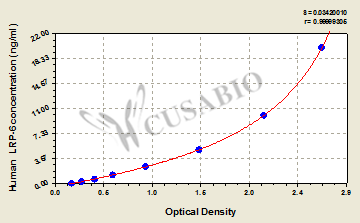| Code | CSB-E08952h |
| Size | 96T,5×96T,10×96T |
| Price | Request a Quote or Start an on-line Chat |
| Trial Size |
24T ELISA Kit Trial Size (Only USD$150/ kit) * The sample kit cost can be deducted from your subsequent orders of 96T full size kits of the same analyte at 1/5 per kit, until depleted in 6 months. Apply now |
| Intra-assay Precision (Precision within an assay): CV%<8% | ||||||
| Three samples of known concentration were tested twenty times on one plate to assess. | ||||||
| Inter-assay Precision (Precision between assays): CV%<10% | ||||||
| Three samples of known concentration were tested in twenty assays to assess. | ||||||
| To assess the linearity of the assay, samples were spiked with high concentrations of Human LRP-6 in various matrices and diluted with the Sample Diluent to produce samples with values within the dynamic range of the assay. | ||||||
| Sample | Serum(n=4) | |||||
| 1:1 | Average % | 88 | ||||
| Range % | 83-91 | |||||
| 1:2 | Average % | 92 | ||||
| Range % | 86-97 | |||||
| 1:4 | Average % | 94 | ||||
| Range % | 88-98 | |||||
| 1:8 | Average % | 102 | ||||
| Range % | 98-104 | |||||
| The recovery of Human LRP-6 spiked to levels throughout the range of the assay in various matrices was evaluated. Samples were diluted prior to assay as directed in the Sample Preparation section. | ||||||
| Sample Type | Average % Recovery | Range | ||||
| Serum (n=5) | 94 | 88-98 | ||||
| EDTA plasma (n=4) | 86 | 82-92 | ||||
| These standard curves are provided for demonstration only. A standard curve should be generated for each set of samples assayed. | |||||||||||||||||||||||||||||||||||||||||||||||||||||||||||||||

| |||||||||||||||||||||||||||||||||||||||||||||||||||||||||||||||
This human LRP6 ELISA kit employs the quantitative sandwich enzyme immunoassay technique to measure the levels of human LRP6 in multiple samples, including serum, tissue homogenates, or cell lysates. It also uses the enzyme-substrate chromogenic reaction to visualize and analyze the analyte levels through the color intensity. The intensity of the colored product is in direct proportion to the LRP6 overexpression has been reported to induce the growth of several types of cancers, including glioblastoma multiforme and gastric cancer. levels in the sample and is measured at 450 nm through a microplate reader.
LRP6 is involved in many biological activities such as cell proliferation, specification, metastatic cancer, and embryonic development. LRP6 is essential for the proper development of different organs in vertebrates, such as Xenopus laevis, chickens, and mice. In humans, LRP6 overexpression and mutations have been found in multiple complex diseases including hypertension, atherosclerosis, and cancers. Clinical studies have shown that LRP6 is implicated in various kinds of cancer, such as bladder and breast cancer.
There are currently no reviews for this product.